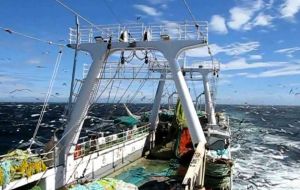MercoPress. South Atlantic News Agency
Falklands: Outwitting canny fur seals feasting on abundant Loligo
 Seal exclusion device with escape hatch at the top of net
Seal exclusion device with escape hatch at the top of net  During the first calamari season, the fleet harvested around 40,000 tons, and two weeks of the second season brought onboard another 10,000 tons of squid.
During the first calamari season, the fleet harvested around 40,000 tons, and two weeks of the second season brought onboard another 10,000 tons of squid.  Aggregations of calamari are so dense that fishing vessels worked up to their freezing capacities having an average of 60-65 tons of squid per vessel per day.
Aggregations of calamari are so dense that fishing vessels worked up to their freezing capacities having an average of 60-65 tons of squid per vessel per day. Falkland Islands Senior Fisheries Scientist Dr Alexander Arkhipkin explains the habits of fur seals and the efforts undertaken to reduce by-catch in the Loligo fishery. Stocks of Falkland calamari (Loligo) are very prolific this year.
During the first season, the fleet harvested around 40,000 tons, and two weeks of the second season brought onboard another 10,000 tons of squid. Aggregations of calamari are so dense that fishing vessels worked up to their freezing capacities having an average of 60-65 tons of squid per vessel per day.
Very unusually this year, dense squid aggregations also attracted their natural predators, fur seals and sea lions into the fishing area. As the vessels concentrate squid in front of the trawl, seals have their feeding frenzy in the close vicinity of the net, and within the net too. In normal conditions, they see the mesh of the net and can easily swim out of it.
But with the ‘snowfall’ of abundant squid the seals become disorientated and swim instead to the long cod-end of the trawl, from where they cannot escape and are drowned. Increased amount of seal casualties (10 drowned animals) was first seen during a fortnight pre-recruitment survey in the second half of July.
This issue was raised at the meeting between Fisheries Department (FIFD) and Loligo Producers Group (LPG) just before the commercial season that agreed to create an Exclusion Zone around Beauchene Island (~5,600 square km) where most of the seal mortalities were observed.
The whole fleet fished to the west of that area, reporting from zero to four fur seal casualties per day. After five days of the fishery, four vessels with observers onboard entered the Exclusion Zone around Beauchene for three days fishing to assess the situation.
The vessels encountered large numbers of squid and unfortunately seals as well. During the first day of their work, the by-catch was minimal with only one mortality reported.
However, as vessels stayed in one area, seals appeared to learn to move to the vicinity of those vessels for easy food. On the second day, many more seals were seen around with a further eight mortalities.
On the third day, despite all the efforts by the captains to avoid seal interactions by steaming full speed for half an hour before shooting (nets), shooting on the turn when the mouth of the net is closed etc, there were 32 casualties reported in the first half of the day. The vessels were instructed to leave the Beauchene Exclusion Zone immediately, without finishing their afternoon trawls.
The situation to the west of the Exclusion Zone was also becoming graver, as the seals accumulated there as well. On August 6, there were nine casualties, and on the August 7, 13 casualties reported.
To prevent further seal mortalities, the whole southern area of the Loligo Box was closed to fishing for at least the next 10 days. Hopefully that would allow seals to disperse and maybe migrate to hunt for southern blue whiting, which spawning aggregations will soon appear to the west of the Loligo Box.
That decision has a huge negative impact on commercial performance of the Loligo fleet, as there is not much squid in the northern part of the Loligo Box at the moment (10-15 tonne per day).
The Falkland Islands Fisheries Department (FIFD) and the Loligo Producers Group (LPG) suggested making seal exclusion devices (SED) to fit to the trawls. The design was similar to that used in other fisheries worldwide.
Two vessels with manufactured SEDs will trial them for five days in the southern area. The observers onboard both vessels will report the performance of SEDs to the Fisheries Department. Any modification to closed areas this year will depend on the effectiveness of SEDs in seal mitigation, as well as seal abundance and distribution.
The Fisheries Department and the industry are making concerted efforts to avoid or decrease seal mortalities to negligible levels as we all should care of not only sustainability of commercial resources, but also about the overall ‘health’ of the marine ecosystem around the Falkland Islands. (Penguin News).




Top Comments
Disclaimer & comment rules-

-

Read all commentsBy a ruling of the UN, Argentina will extend its maritime platform (Politica Argentina) ; New map of the maritime platform reaffirms the sovereignty of Malvinas with UN endorsement (ElCronista); Argentina enlarges its territory 35%, with a UN endorsement ...(La Capital).
Aug 18th, 2017 - 10:37 am +1But what is the truth?
Argentina's Continental Shelf Claims and The UN CLCA Commission (1 page):-
https://www.academia.edu/33898951/Argentinas_Continental_Shelf_Claims_-The_UN_CLCS_Commission
It is a well-established practice, accepted as law that title over the natural resources is to follow that over territory; accordingly the sovereign subject enjoys the exclusive right to dispose of the natural wealth of the area which it exercises sovereignty. ( UN Stockholm Declaration, 1972, Principle 21, and the UN Rio Declaration 1992, Principle 2, Declarations on the Human Environment).
So why treat the Argentinian public like children?
England will return the Malvinas within 25 years.
Aug 21st, 2017 - 04:56 am 0Commenting for this story is now closed.
If you have a Facebook account, become a fan and comment on our Facebook Page!